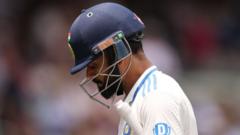After suffering a damaging 1-3 defeat in the Border-Gavaskar Trophy against Australia, the Indian cricket team's dominance faces serious scrutiny. Key players show troubling form, igniting questions about their ability to recover and the succession plans for their golden era. Young talents emerge amidst a landscape of uncertainty in Indian Test cricket.
India’s Test Cricket Legacy in Jeopardy: Reflection and Future Prospects

India’s Test Cricket Legacy in Jeopardy: Reflection and Future Prospects
A closer look at India's fall from grace in Test cricket following a heavy defeat to Australia, examining the implications for the team's future and emerging talents.
In a shocking turn of events, Indian cricket fans are grappling with the consequences of the team’s recent performances, particularly a bleak 1-3 loss to Australia in the five-match Test series. Once a powerhouse in the Border-Gavaskar Trophy, India’s recent defeat has laid bare the vulnerabilities of a team that was long considered untouchable.
The series served as a wake-up call, revealing significant issues; Indian batters struggled to find form, and the only bowler to consistently trouble the Australians was Jasprit Bumrah. This disappointing outcome not only meant losing the prestigious Border-Gavaskar Trophy but also thwarted India’s hopes of competing in the World Test Championship (WTC) final, ending a streak of appearances in the last two finals held in 2021 and 2023.
India has now lost six of its last eight Test matches, including a devastating 0-3 home series defeat against New Zealand. These setbacks have sparked a wave of speculation regarding the future of key players, including captain Rohit Sharma and former captain Virat Kohli, as the team navigates this transitional phase amid the fading prowess of its stalwarts.
The upcoming five-Test series in England poses another significant challenge for India. The unpredictable English conditions will test the players' technical abilities, mental resilience, and adaptability. Notably, India hasn't secured a Test series win in England since 2007. With their recent failures against New Zealand and Australia, selectors face the challenging task of making crucial decisions regarding player selection and combination strategies for the vital campaign.
Rohit Sharma's struggles were evident, with the captain managing just 31 runs across three Tests in Australia before opting to sit out the final match. Kohli offered somewhat better statistics, scoring 190 runs in nine innings but failing to convert good starts into substantial contributions, raising questions about his technical precision and mental fortitude under pressure. Since January 2024, Sharma’s performance has declined, amassing just 619 runs in 16 Test matches, while Kohli’s average of 32 since 2020 shrouds his once-glorious career in doubt.
Despite the ongoing struggles, the Indian setup boasts a pool of emerging talent. Young batsman Yashasvi Jaiswal emerged as a standout player in Australia, displaying an impressive combination of aggression and technique that could signal a bright future for the team. Potential successors to the veteran players are being closely monitored, with promising performances from youngsters like Abhishek Sharma and Nitish Kumar Reddy displaying key qualities to fill the void.
On the bowling front, Bumrah has emerged as a critical figure, securing 32 wickets against Australia. However, careful workload management will be crucial to avoid injury issues that could hinder his performance. The spin department faces challenges with the recent retirement of Ravichandran Ashwin and a lackluster showing from Ravindra Jadeja. Nonetheless, fresh talents, including Washington Sundar and young spinners like Ravi Bishnoi, are poised for potential impact.
The Indian cricket board is making moves to revamp the team, encouraging experienced players like Sharma and Kohli to participate in domestic leagues to regain their form. This decision could be pivotal in shaping the future of Indian Test cricket.
Managing a transitional team requires a delicate approach—a balance of patience and strategic planning without succumbing to external pressures. While the current phase is challenging, India’s wealth of young talent may brighten the outlook for its cricketing legacy. It calls to mind the nation’s resurgence after the 0-4 drubbing suffered against England and Australia in 2011. Just months later, a crop of young players, including players like Kohli and Sharma, transformed the landscape, establishing India as a leading force in world cricket for nearly a decade.





















